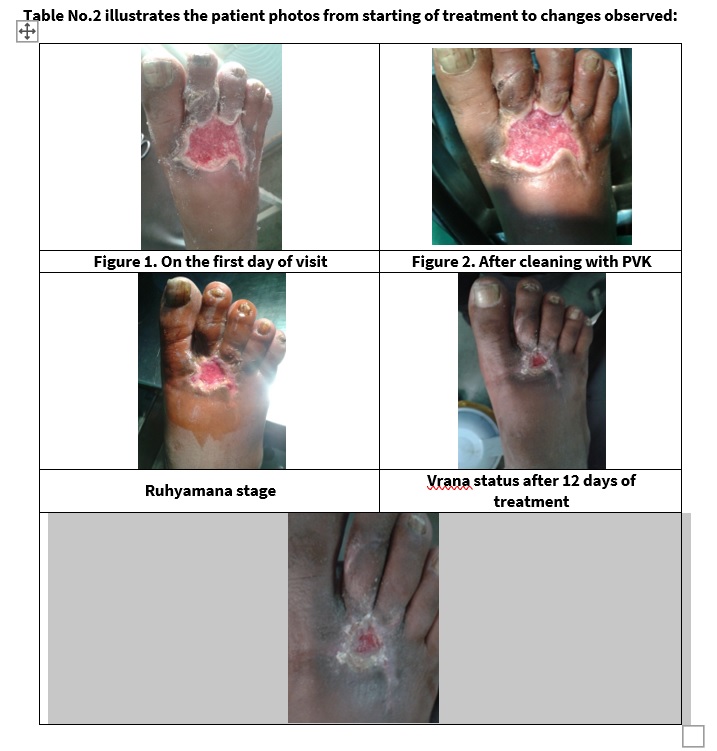Case Report
Year: 2020 |Volume: 1 | Issue: 9 |Pages: 335-338
Vranopachara – Shuddha Vrana Management– A Case Study
About Author
Correspondence Address:
Dr.Sathish HS Professor, Department of Shalya Tantra, TMAE’s Society Ayurvedic Medical College, Shimoga, Karnataka Mob: 9886969216 Email: ayursathishhs@gmail.com
Date of Acceptance: 2020-12-26
Date of Publication:2020-11-07
Article-ID:IJIM_43_01_20 http://ijim.co.in
Source of Support: NIL
Conflict of Interest: NIL
How To Cite This Article: Rashmi TM, Sathish HS, Mithun B, Narmada MG. Vranopachara – Shuddha Vrana Management– A Case Study. Int. J Ind. Med. 2020;1(9):335-338
Abstract
An abundant detail on the various aspects of the wound, its etiopathology, modes of healing and enhancing the cosmetic benefits are readily available in Ayurvedic surgical treatise, Sushruta Samhita. A proper and methodical application of the principles of healing will yield positive outcomes in the treatment; identification of the etiology, diagnosing the case is always the primary step prior to plan any modes of medication or treatment. In this case study, a case of Shuddha vrana is assisted to heal by employing simple medications and avoidance of the cause.
Keywords: Vrana, healing, Shuddha vrana
Introduction
Cases of Vrana are a routine in the clinical practice, clinician thrives hard to give the best solution in order to achieve a faster healing with minimal scar and good cosmetic outlook.1 Ayurveda offers numerous modalities to heal the wound and a number of studies across the globe are being carried out to understand the principles of healing and its applicability suitable to the current era. In this case study, we tried to showcase a case of non healing wound treated with simple, easily available medications to achieve the complete healing.
Case details and Discussion:
A 40 year old male patient visited the OPD with presenting complaints of non healing wound since one month which he occurred due to traumatic injury during his agriculture works.
Patient didn’t have any other associated complaints. Patient presented with a wound on the dorsum of the right foot with pain and slight itching sensation. The size of the ulcer was 3cm ×4.5cm with red granulation tissue and a sloping edge. The features of shyava oshta [pale greyish edge], pidaki sama [healthy granulation tissue], mridu [soft], snigdha [moist surface], nirasrava [no discharge], avedana [less pain] were observed in the vrana suits to be diagnosed as Shuddha vrana.

illustrates the patient photos from starting of treatment to changes observed:
Discussion
In this case plan of treatment was mainly to improve the agni [digestion] and potentiate the healing process by internal tikta dravya administration.2 Topically wound was cleaned with panchavalkala kashaya3 and Jatyadi taila4 was applied. Wound dressing was done on alternate days till complete healing is achieved.
Table No. 1 depicts the drug administered with the posology:
|
Sr. NO. |
Medication |
Dose with Anupana |
|
1 |
Pancha tikta Ghrita Guggulu |
2-tab TID after food with lukewarm water |
|
2 |
Triphala Churna |
1Tsp with lukewarm water at bedtime |
Shuddha vrana usually requires less medication or no medication, in this case we administered few medicines in order to fasten the healing process as the wound hasn’t healed in the last one month, the possible reasons for non healing were screened, and following reasons were identified - improper wound hygiene, not getting wound dressing due to economical constraints and being held busy in agriculture activities and continuous strain to the foot during farming works. As there were no significant hindering factor of vascularity or bony injury or sepsis were noticed which could halt the healing process, patient was advised to give rest to the part and follow the treatment protocol which he subsequently observed with punctuality.
Conclusion
Diagnosis is of wound is a prerequisite before planning any treatment modality, and adherence to the Sushruta’s principles of healing will aide in achieving the complete epithelialisation.
References
value="
- Mehra R. Historical survey of wound healing. Bull Indian Inst Hist Med Hyderabad. 2002 Jul 29;32(2):159-75.
- Ghodela NK, Dudhamal T. Wound healing potential of Ayurved herbal and herbo-mineral formulations: A brief review. International Journal of Herbal Medicine. 2017;5(1):39-45.
- Rathod S, Khandare K, Shrivastava P. Efficacy of Panchavalkal Kwatha Dhawana followed by Panchavalkal Ghruta application in case of Dushta Vrana. Journal of Ayurveda and Integrated Medical Sciences (ISSN 2456-3110). 2019 Sep 26;4(4):345-9.
- Shindhe PS, Ramesh Shivappa Killedar LS, Santosh YM, Madiwalar M. Evaluation of Wound healing activity of Jatyadi Ointment and Jatyadi taila in the management of clean wound (ShuddhaVrana)-A Randomised Controlled Trial.
"

